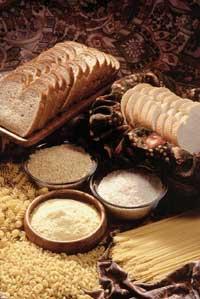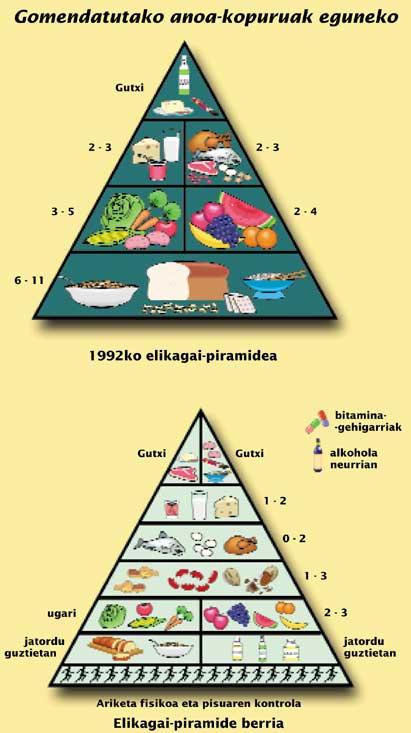Rebuilding the food pyramid

The USDA food pyramid shows how much to eat for each type of food. At the base of the pyramid there are foods with complex carbohydrates: bread, pasta, rice, potato... On the next level are fruits and vegetables, which are the sources of protein: dairy, meat, fish and eggs. At the top of the pyramid you have to avoid it or consume it much as you like: fats, sweets and oils. The message is simple and simple: complex carbohydrates are good and fats are bad.

For the realization of the pyramid were taken into account the investigations carried out to date. Reviews have since been published, the last in 2000. They have tried to reflect the results and conclusions of the latest studies in the field of nutrition, but basically the same pyramid has been used. However, they have now decided to rebuild the pyramid and hope that the new one will be presented for next year.
Not all fats are equal
In fact, in the ancient pyramid there are notable defects. For example, fats are practically prohibited, since during the pyramid a direct relationship was observed between the amount of fat ingested with food and circulatory problems. But this occurs mostly in developed countries, mainly due to the use of saturated fats. Conversely, in the east and elsewhere, a lot of unsaturated fats are consumed. However, they have no heart and circulation problems, but quite the opposite. It is clear that not all fats are the same.
Fats have also been linked to cancer risk. However, recent studies indicate that saturated fats increase the risk of breast and prostate cancer. On the other hand, unsaturated vegetable oils do not appear to have harmful effects and there are studies that point to a decrease in this risk.

Finally, fats have been accused of being primarily responsible for obesity. In fact, a gram of fat provides more calories than a gram of protein or carbohydrates; in addition, the process of fat accumulation in the body is more effective than that of carbohydrates or proteins. However, recent studies have found that limiting fat during food has little to do with obesity. The best way to avoid obesity is by limiting the total number of calories, not just fat intake.
The problem of carbohydrates

The debate also arises around the carbohydrates at the base of the pyramid. Simple carbohydrates are long chains made up of sugar units such as glucose and fructose. These sugar units do not contain vitamins, minerals or other nutrients, contain ‘empty calories’, so they are at the top of the pyramid. On the contrary, complex carbohydrates contain other nutrients that placed them at the base of the pyramid.
However, refined carbohydrates, such as white bread or white rice, are not as beneficial as expected. In the refining process minerals and fiber are lost, leaving a type of starch that is easily absorbed. This starch is rapidly metabolized and increases blood glucose levels.

The potato has a similar effect: a cooked potato raises blood glucose levels more than the sugars on the table. Being starch the main component of the potato, it is metabolized very quickly to give glucose. Table sugar is a disaccharide made up of two glucose and fructose molecules. Fructose takes a long time to become glucose, thereby decreasing the increase in blood glucose.
According to epidemiological studies, excessive intake of starchy foods increases the risk of diabetes and circulatory problems. Unrefined carbohydrates, on the contrary, have an adverse effect thanks to their fiber. All this must be taken into account in the new pyramid.
Protein sources
As for protein-rich foods, red meat, fish, chicken, eggs, green beans and nuts appear together in the pyramid. However, they cannot be put in the same bag, as they have different characteristics.

Saturated fat from red meat is associated with the risk of heart and blood circulation problems. On the other hand, some of the substances produced by burning these meats are causing colon cancers. However, chicken and fish contain more unsaturated fat than red meats and fish also contains omega-3 fatty acids essential for the body. Therefore, chicken and fish are much healthier than red meat.
On the other hand, eggs are often discarded for their high cholesterol content, but it does not seem that the daily consumption of one of them can cause damage to the blood circulation. Apparently, eggs contain other ingredients that counteract the effect of cholesterol. Something similar happens with nuts. Despite its high fat content, it is unsaturated and includes omega-3, so they are beneficial for blood circulation.
At the same level as the pyramid there are dairy products. Researchers, however, consider it convenient to take less than recommended here. Although calcium is necessary, dairy abuse is associated with prostate cancer in men and ovaries in women. To meet women's calcium needs after menopause, doctors recommend calcium supplements instead of dairy.
Healthier pyramid

These are just some of the reasons that justify the reconstruction of the pyramid. Those who strictly follow the recommendations of the old pyramid have healthy habits, especially because they eat a lot of vegetables and fruit, but other aspects are not so beneficial: they have the risk of abusing polyunsaturated fats and starches. Finally, the benefits and damages are equated.
The renewed pyramid attaches great importance to an adequate weight, and for this, the main aspects to be monitored are physical exercise and the total number of calories ingested. On the other hand, the food groups that stand out in the new pyramid are unsaturated fats and complex unrefined carbohydrates. It is recommended to moderate the intake of protein sources and reduce dairy compared to the previous one.

On the other hand, in the renewed pyramid it is mentioned that vitamin additives are recommended for most people, and that drinking a little alcohol not only harms, but benefits. This is expected to reduce the risk of chronic diseases. However, experts believe that further research is needed, as there are things that are not yet fully clear, such as the effect of long-term vitamin additives or the relationship between diet and genetics.
In addition, they consider essential the support of the food industry to socialize the new pyramid, which, through advertising, has a great influence on eating habits.

Buletina
Bidali zure helbide elektronikoa eta jaso asteroko buletina zure sarrera-ontzian











